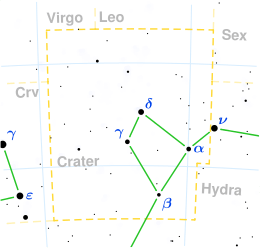Zeta Crateris
Zeta Crateris (ζ Crateris) is a probable binary star[3] system in the southern constellation of Crater. Zeta Crateris appears to be about half-way between Epsilon Corvi to the southeast and Beta Crateris to the northwest, and marks the lower left corner of the rim of the bowl. Eta Crateris lies somewhat less than half of the way from Zeta Crateris to Gamma Corvi, the bright star above, (north) of Epsilon Corvi.
 | |
| Observation data Epoch J2000.0 Equinox J2000.0 (ICRS) | |
|---|---|
| Constellation | Crater |
| Right ascension | 11h 44m 45.77615s[1] |
| Declination | −18° 21′ 02.4298″[1] |
| Apparent magnitude (V) | 4.740[2] (4.95 + 7.84)[3] |
| Characteristics | |
| Spectral type | G8 III[4] |
| U−B color index | +0.724[2] |
| B−V color index | +0.961[2] |
| Astrometry | |
| Radial velocity (Rv) | −4.10±0.33[5] km/s |
| Proper motion (μ) | RA: +26.703 ± 0.520 [6] mas/yr Dec.: −26.970 ± 0.346[6] mas/yr |
| Parallax (π) | 10.0112 ± 0.2795[6] mas |
| Distance | 326 ± 9 ly (100 ± 3 pc) |
| Absolute magnitude (MV) | −0.66[7] |
| Details | |
| Radius | 13[8] R☉ |
| Luminosity | 157[9] L☉ |
| Surface gravity (log g) | 2.60[7] cgs |
| Temperature | 4,992[7] K |
| Metallicity [Fe/H] | +0.03[7] dex |
| Age | 251[7] Myr |
| Other designations | |
| Database references | |
| SIMBAD | data |
Zeta Crateris is a photometrically constant[11] system that is visible to the naked eye with an apparent visual magnitude of 4.740.[2] With an annual parallax shift of 9.24[1] mas as viewed from Earth, Zeta Crateris is located roughly 350 light years from the Sun. At that distance, the visual magnitude of the system is diminished by an extinction factor of 0.21 due to interstellar dust.[7]
The two components of this system had an angular separation of 0.20 arc seconds along a position angle of 22°, as of 1991.[12] The primary, component A, is a magnitude 4.95 evolved giant star with a stellar classification of G8 III.[4] It is a red clump star that is generating energy through the fusion of helium at its core.[13] Zeta Crateris has expanded to 13[8] times the radius of the Sun and shines with 157[9] times the Sun's luminosity. This energy is being radiated into outer space from the outer envelope at an effective temperature of 4,992 K.[7]
The secondary, component B, is a magnitude 7.84 star.[12] Zeta Crateris is a confirmed member of the Sirius supercluster[14] and is a candidate member of the Ursa Major Moving Group, a collection of stars that share a similar motion through space and may have at one time been members of the same open cluster.[15]
References
- van Leeuwen, F. (2007), "Validation of the new Hipparcos reduction", Astronomy and Astrophysics, 474 (2): 653–664, arXiv:0708.1752, Bibcode:2007A&A...474..653V, doi:10.1051/0004-6361:20078357.
- Jennens, P. A.; Helfer, H. L. (September 1975), "A new photometric metal abundance and luminosity calibration for field G and K giants", Monthly Notices of the Royal Astronomical Society, 172: 667–679, Bibcode:1975MNRAS.172..667J, doi:10.1093/mnras/172.3.667.
- Eggleton, P. P.; Tokovinin, A. A. (September 2008), "A catalogue of multiplicity among bright stellar systems", Monthly Notices of the Royal Astronomical Society, 389 (2): 869–879, arXiv:0806.2878, Bibcode:2008MNRAS.389..869E, doi:10.1111/j.1365-2966.2008.13596.x.
- Houk, Nancy; Smith-Moore, M. (1978), Michigan catalogue of two-dimensional spectral types for the HD stars, 4, Ann Arbor: Dept. of Astronomy, University of Michigan, Bibcode:1988mcts.book.....H.
- de Bruijne, J. H. J.; Eilers, A.-C. (October 2012), "Radial velocities for the HIPPARCOS-Gaia Hundred-Thousand-Proper-Motion project", Astronomy & Astrophysics, 546: 14, arXiv:1208.3048, Bibcode:2012A&A...546A..61D, doi:10.1051/0004-6361/201219219, A61.
- Brown, A. G. A.; et al. (Gaia collaboration) (August 2018). "Gaia Data Release 2: Summary of the contents and survey properties". Astronomy & Astrophysics. 616. A1. arXiv:1804.09365. Bibcode:2018A&A...616A...1G. doi:10.1051/0004-6361/201833051. Gaia DR2 record for this source at VizieR.
- Takeda, Yoichi; et al. (August 2008), "Stellar Parameters and Elemental Abundances of Late-G Giants", Publications of the Astronomical Society of Japan, 60 (4): 781–802, arXiv:0805.2434, Bibcode:2008PASJ...60..781T, doi:10.1093/pasj/60.4.781.
- Pasinetti Fracassini, L. E.; et al. (February 2001), "Catalogue of Apparent Diameters and Absolute Radii of Stars (CADARS)", Astronomy and Astrophysics (3rd ed.), 367: 521–524, arXiv:astro-ph/0012289, Bibcode:2001A&A...367..521P, doi:10.1051/0004-6361:20000451.
- McDonald, I.; et al. (2012), "Fundamental Parameters and Infrared Excesses of Hipparcos Stars", Monthly Notices of the Royal Astronomical Society, 427 (1): 343–57, arXiv:1208.2037, Bibcode:2012MNRAS.427..343M, doi:10.1111/j.1365-2966.2012.21873.x.
- "* zet Crt". SIMBAD. Centre de données astronomiques de Strasbourg. Retrieved 2017-03-01.
- Choi, Hyung-Jin; et al. (August 1995), "A Study of Variability in a Sample of G and K Giants", Publications of the Astronomical Society of the Pacific, 107: 744, Bibcode:1995PASP..107..744C, doi:10.1086/133617.
- Mason, B. D.; et al. (2014), "The Washington Visual Double Star Catalog", The Astronomical Journal, 122: 3466–3471, Bibcode:2001AJ....122.3466M, doi:10.1086/323920, retrieved 2015-07-22
- Alves, David R. (August 2000), "K-Band Calibration of the Red Clump Luminosity", The Astrophysical Journal, 539 (2): 732–741, arXiv:astro-ph/0003329, Bibcode:2000ApJ...539..732A, doi:10.1086/309278.
- Eggen, Olin J. (August 1998), "The Sirius Supercluster and Missing Mass near the Sun", The Astronomical Journal, 116 (2): 782–788, Bibcode:1998AJ....116..782E, doi:10.1086/300465.
- King, Jeremy R.; et al. (April 2003), "Stellar Kinematic Groups. II. A Reexamination of the Membership, Activity, and Age of the Ursa Major Group", The Astronomical Journal, 125 (4): 1980–2017, Bibcode:2003AJ....125.1980K, doi:10.1086/368241.